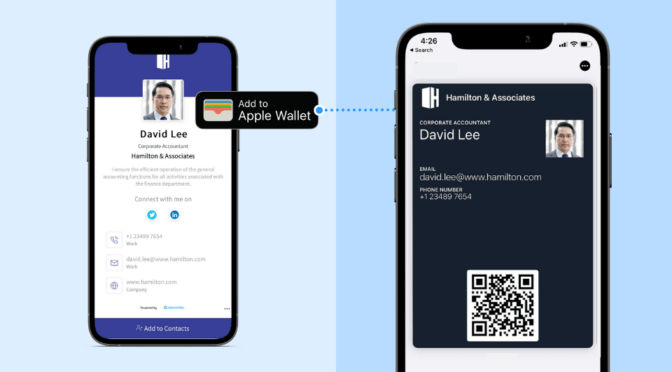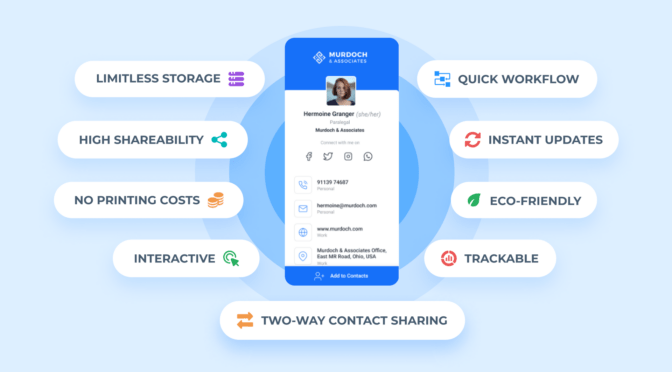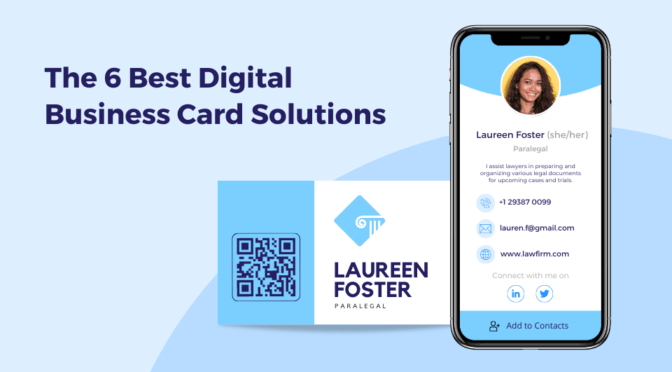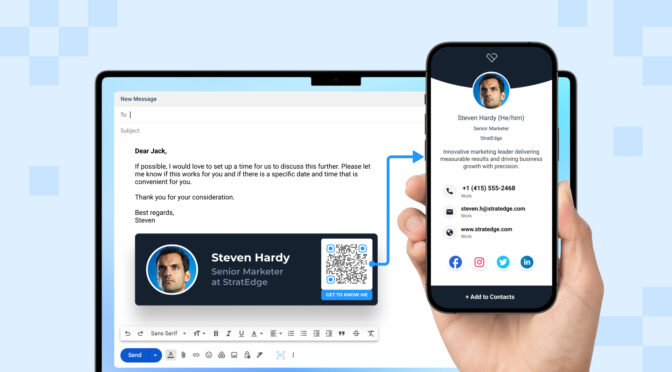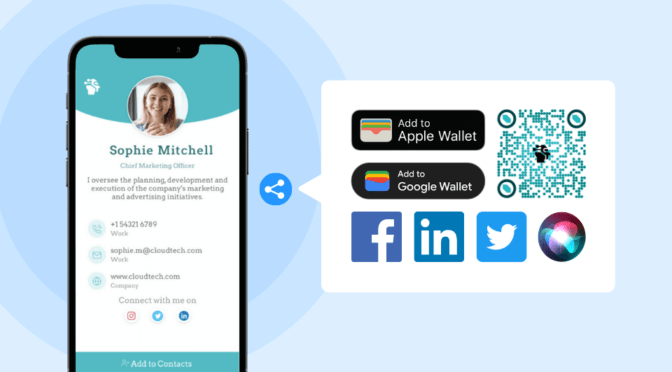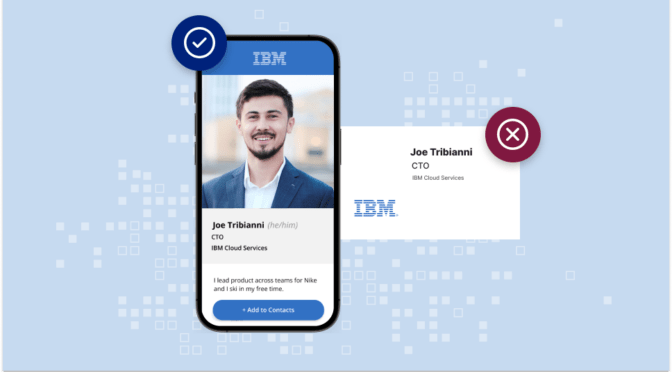There once was a time when people exchanged paper business cards to network professionally and spread the word about their business. But, as the digital transformation took over in the last couple of years—people can now seamlessly share their contact information through virtual business cards, a.k.a, digital business cards.
Traditional business cards are typically discarded in today’s tech-driven world because people naturally want to opt for convenience. Busy professionals today would much rather get information in a few clicks instead of sorting through irrelevant physical cards.
This is where virtual business cards come in handy.
Using a virtual business card allows you to transfer your details to your client via a smartphone, so they have everything they need—in a convenient and instant manner.
Want to learn more? This blog post will give you an in-depth insight into virtual business cards and their benefits, how to create them, and who can use them to supercharge their networking efforts.
Table of contents
- What is a virtual business card?
- 9 reasons why switching to a virtual business card is recommended
- How do I create a virtual business card?
- How to generate 2,000 virtual business cards in less than 5 minutes
- List of professionals who can use virtual business cards
- 8 factors to consider when choosing a virtual business card maker
- Frequently asked questions (FAQs)
What is a virtual business card?
A virtual business card is a contactless, secure, and digital way of sharing information about an individual or a business. You can use it to share your name, email address, mobile number, web URLs, or even social media links.
Here’s an example of what virtual business cards can look like:

A virtual or digital business card safeguards your personal details in an online format called .vcf (virtual contact file). This contact information card can be easily shared in multiple contactless ways—through Apple or Google Wallets, QR Codes, email signatures, social media posts, and URLs.
9 reasons why switching to a virtual business card is recommended
Below are the 9 reasons why switching from traditional to virtual business cards can be incredibly beneficial for your networking:
- Share more information quickly
- An instant two-way communication channel
- Leave a memorable impression
- Track card-scan metrics to gauge user behavior
- Update your virtual business cards anytime, anywhere
- Quick and contactless card-sharing
- Leverage two-way contact sharing for convenient lead collection
- Significantly cut down on card printing costs
- An eco-friendly alternative
#1 Share more information quickly
A traditional business card is merely 7 square inches long. Due to its compact dimensions, you may experience difficulty adding and sharing all the information you want.
Fortunately, a virtual business card doesn’t present these challenges.
You can include all the important details—from your company’s Google Maps location to your social media handles—on your business card. You can also add a Calendly meet link so people can schedule meetings with you—without worrying about running out of space.
Read here to find out what information to put on a digital business card.
#2 An instant two-way communication channel
When you hand over a paper business card to your clients, they need to manually access the content on your card. This means they cannot instantly interact with your business card.
However, as virtual business cards contain clickable information, your clients can quickly scan and access your contact details. This lets them reach out to you in real-time and at their convenience.
#3 Leave a memorable impression
The most effective business cards are the ones that leave a lasting impression. 72% of professionals will judge your company by the quality of your business cards, so why not make them appealing and contemporary?
Presenting a virtual business card while networking showcases that you are tech-savvy and modern. Also, when you choose a customizable digital business card solution, you get to pick from various card designs and colors per your company’s brand identity.
#4 Track card-scan metrics to gauge user behavior

Want to know how many people have scanned your card or how many times it has been scanned at a particular location?
Unlike their physical counterparts, virtual business cards give you an insight into the effectiveness of your team’s networking efforts.
You can learn about the number of total card views, unique card views, and the location of the people who accessed your card. Not to mention you can also integrate Google Analytics to understand demographics and user behavior.
#5 Update your virtual business cards anytime, anywhere
What happens when you want to change your email address or phone number on a traditional business card? Getting another fresh batch of cards printed for even the slightest updates in your information would be a costly ordeal. It would prove counterproductive to you and your prospective clients who want to reach out to you but don’t have your updated details.
With virtual business cards, you can keep your information up-to-date and can regularly refresh your information—without having to recreate or reshare the card.
#6 Quick and contactless card-sharing
COVID-19 has expanded the usage of contactless solutions—especially when it comes to payments and food deliveries—to maintain hygiene. The same has since applied to exchanging business cards.
Virtual business cards are a convenient paper business card alternative that lets you share your information without having to physically hand over anything. This makes it easier for your network to access your data on their smartphones.
How, you ask?
You can share your virtual or digital business card as an Apple Wallet pass (or Google Wallet pass), so you can interact with industry experts in a paperless and professional manner.

#7 Leverage two-way contact sharing for convenient lead collection
Virtual business cards let you enable two-way contact-sharing to instantly capture your client’s contact details directly from the card you share.
Here’s how it works:
- You share your virtual business card with your client.
- Your client views your card on their mobile device.
- Your client fills out and submits a contact form through your card itself.
Each contact form submission you acquire gets recorded as a new lead entry in a virtual address book on your digital business card provider’s dashboard.
You can access this virtual address book to view and manage all the warm leads you have collected. You can then export this leads list directly to Salesforce or 700+ other CRM tools via Zapier.
This feature streamlines the exchange of contact information between you and your client, removing unnecessary friction in the process. This friction includes manually saving contact information on a mobile device or a lead management system.
#8 Significantly cut down on card printing costs
Custom designing, ordering, and printing paper business cards for an entire company can be a costly affair. The more design-heavy you want your cards to be, the costlier they become. Given that for a single employee, the annual cost of printing a business card in the US is $194, for a team of just 250 employees, it would cost $48,500.
But with a digital business card generator, you can make and share 250 business cards for $588 a year. That is almost $40,000 saved annually.
Switching to virtual business cards means saving huge amounts of money while avoiding all of the inconveniences associated with paper-based cards.
#9 An eco-friendly alternative

While we are in the golden age of technology, paper-based business cards still bear relevance: with over 27 million cards printed annually. But given that most of these cards are thrown away, it negatively impacts the environment as well.
Virtual business cards are an eco-friendly solution where you wouldn’t have to store heaps of them in a drawer but instead can have them in your digital wallet.
Learn what makes virtual or digital business cards the most eco-friendly business card alternative today.
How do I create a virtual business card?
Now that you know the benefits of using a virtual business card, you might want to create one yourself.
To create virtual business cards that allow you to achieve your networking goals, we recommend using a capable and robust digital business card solution. With a dedicated solution, you can leverage a full range of features and functions that make virtual business card creation and distribution convenient and impactful.
Learn more about virtual business card creation by referring to our easy-to-implement guide on how to create a virtual business card.
How to generate 2,000 virtual business cards in less than 5 minutes
Want to make virtual business cards for all your employees in one go?
You can leverage Uniqode’s virtual business card maker to bulk-create up to 2,000 digital business cards at once. This allows you to save an enormous amount of time and effort as opposed to manually creating your virtual business cards individually.
Step 1: Navigate to the left panel and click ‘QR Codes’

Step 2: Click ‘Bulk upload’ and select ‘Digital Business Card’

Next, click on the “Digital Business Card” campaign.

Step 3: Download the spreadsheet template and fill in all the relevant details
You can download a CSV or an XLSX version of the bulk-upload template.

This template contains table headings to match the information field on your virtual business card. You can add the relevant details under each column.

Added Tip: You can delete columns as necessary. But ensure a consistent data arrangement to avoid errors during the bulk-creation process.
Step 4: Upload the populated spreadsheet file
Note: You must upload your spreadsheet in either CSV or XLSX formats.

Once you’ve uploaded the file, the platform generates the virtual business card batch. You can proceed to the next step if there are no data inconsistencies.
Step 5: Under the ‘Branding’ tab, you can customize the look and feel of your virtual business cards

From the ‘Layout’ tab, you can choose your preferred card layout.

Under the ‘Settings’ tab, you can toggle on the following features:
- Directly download vCard on scan: Upon scanning, this will instantly load your virtual business card on your prospect’s mobile device—letting them save your contact information in one click.
- Auto-send Wallet Passes to owners: Upon creation, every virtual business card will be sent to its owner, i.e., to the email address used in each card. Through that email, the recipient can add the card to their Apple or Google Wallet.

Note: These settings will apply to every virtual business card in the batch.
Step 6: Customize the QR Code of your virtual business card batch

Note: All visual customizations you make apply to every business card QR Code associated with each virtual business card in your batch.
Once you’re done with the customizations, click Finish.
Step 7: Label the batch you’re about to generate
Labels help you efficiently manage numerous virtual business card batches. Once you’ve labeled a particular batch, it will be easier to find and filter it in the future.

After assigning your batch label a suitable name and color, click Apply.
Step 8: You’ll be notified via email as soon as your batch is ready

Once you’ve added a Label to your batch and clicked Apply, you will see a message that tells you your bulk request is being processed.
You’ll be notified via email as soon as your batch is ready. Once you receive the email notification, go back to the dashboard to view your newly-generated virtual business card batch.
Who can use virtual business cards?
While professionals across any industry can benefit from virtual business cards, the following are among the most popular ones:
Realtors
Networking plays a significant role when establishing trust with home buyers. While most realtors hand out traditional business cards to their clients, 88% of these cards end up in the trash.
However, a virtual business card can resolve this issue.
As soon as clients scan your virtual business card, they can instantly save your details, eliminating the need to keep a physical card for later use. Realtors can conveniently share their contact information, including links to websites where houses are available for rent or sale.
RELATED: Best Digital Business Card Makers for Realtors
Lawyers

When seeking a lawyer, 59% of clients want to refer to someone they know. Meanwhile, many attorneys cling to old-fashioned networking and still distribute paper business cards to their clients for word-of-mouth marketing. However, this is not the best solution as people can easily misplace a paper business card, resulting in lost business for the lawyer.
Fortunately, a virtual business card can help lawyers network in a paperless manner, eliminating the need for clients to store paper or any physical medium-based cards. With a virtual business card, your clients can save all the information they require in a single click. This includes phone numbers and links to a law firm’s website or Calendly to schedule meetings.
RELATED: 5 Reasons Why Lawyers Should Use Digital Business Cards
Healthcare professionals
Healthcare professionals such as doctors and nurses typically have fast-paced lifestyles. For this reason, these professionals can benefit from virtual business cards’ ability to streamline client interactions.
For instance, a virtual business card can display links allowing quick credential verification. It can also provide a clickable URL that redirects clients to where they can conveniently book a consultation.
Financial advisors

Financial independence has become one of the top priorities for people in recent years, and over 71% of individuals trust financial advisors when making major monetary decisions. If you’re a financial advisor looking to find clients, you can use a virtual business card to increase your business’ reach.
Add a link to your website and client testimonials so your prospects can see how your past clients have benefitted from your services. This will allow prospective investors to examine your credibility, making them further inclined to work with you.
Insurance agents
Insurance agents interact with multiple people throughout the day, but they still face problems with conversions since they need more than one interaction to convince their clients.
Offering a physical business card is unlikely to solve this problem since it can be easily misplaced. Conversely, when you share your details via a virtual business card, your prospects can save your details the moment you share it. Once stored on their device, your clients can access your business card details at any time.
With a digital business card, insurance agents can share their contact details and links to their websites, showcasing different customer plans.
Now that you know how to use a virtual business card to boost your networking efforts, you might want to know how to choose the right virtual business card maker. In the following section, we give an overview of the 8 crucial factors you must consider when choosing the best virtual business card maker.
8 factors to consider when choosing the best virtual business card maker
- Ease of use
- Intuitive user experience
- Card customizability
- Multiple contactless ways of sharing information
- Card analytics and tracking
- Bulk card creation capability
- Security and compliance
- API and integrations

#1 Ease of use
Creating a virtual business card should not be an overly complicated process. Ensure you opt for a solution where you can easily make your digital business card in just a few minutes.
#2 Intuitive user experience
A clunky UI can be frustrating, especially when you want to create virtual business cards for your entire team. Pick a virtual business card maker where the user interface is clean and consistent to avoid any obstacles in the process.
#3 Card customizability
Your virtual business card design must stand out if you want to impress your prospects. Choose a solution where you can customize card templates by adding your logo and colors according to your company’s brand identity.
#4 Multiple contactless ways of sharing information
While QR Codes are a great way to send out information, they are not the sole means to provide a contactless experience. Find a solution where you can share your details via other methods such as Apple or Google Wallet passes, social media, URLs, and email signatures.
#5 Card analytics and tracking
One thing that makes virtual business cards stand out is their ability to track your card’s user engagement in real-time. Find a solution where you can track engagement metrics, such as the number of views of your card, best and worst performing cards, views by location and devices, user demographics, and more.
#6 Bulk card creation capability
If you want to create hundreds or thousands of virtual business cards quickly, choose a solution that offers the bulk creation feature. This will significantly reduce the effort and time taken to create a batch of cards manually.
#7 Security and compliance
Virtual business cards contain critical information about your team, and it’s crucial to secure this data. Choose a virtual business card maker that follows the best security standards, such as GDPR and SOC II Type-2 compliance. Check out our in-depth guide on how to choose the most secure digital business card solution.
#8 API and integrations
When creating virtual business cards at scale, pick a solution that offers API integrations with the right tools, such as Google Analytics, Zapier, Make, and more. Ensure the platform also supports integration testing to verify that these connections function seamlessly across all tools.
Check out our comparison guide on the best digital business card makers available today. In this guide, we tested the most popular virtual business card solutions to see how they perform on the above 8 parameters to help you choose the most suitable solution for your business.

Frequently asked questions (FAQs)
How do I make a virtual business card using Uniqode?
- Head over to Uniqode’s digital business card solution.
- Sign up for the free plan.
- On the dashboard, go to the ‘Create Digital Business Card’ tab.
- Choose your preferred card layout from the various options available.
- Enter the contact details. Learn what information to put on a virtual business card.
- Customize your business card QR Code.
- Save and share your virtual business card using Apple or Google Wallet, QR Code, social media, email signature, etc.
Can I create virtual business cards for over 1000 employees in bulk?
Yes, you can. Uniqode allows you to create up to 2000 virtual business cards in just 5 minutes. All you have to do is enter the details in our pre-defined template (Google/Excel spreadsheet) and request a batch of cards, which will be delivered to your email in less than 5 minutes.
What is the difference between a digital business card and a virtual business card?
Digital business cards, also known as virtual business cards, are a contactless, secure, and modern way of sharing contact information about an individual or a business. Through these e-business cards, you can also share multimedia content such as web URLs (landing pages, YouTube videos, your blog, etc.), social media links, Google Maps location, and more.








